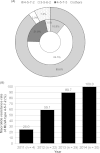Emergence of Macrolide-Resistant Mycoplasma pneumoniae in Hong Kong Is Linked to Increasing Macrolide Resistance in Multilocus Variable-Number Tandem-Repeat Analysis Type 4-5-7-2
- PMID: 26338857
- PMCID: PMC4609705
- DOI: 10.1128/JCM.01983-15
Emergence of Macrolide-Resistant Mycoplasma pneumoniae in Hong Kong Is Linked to Increasing Macrolide Resistance in Multilocus Variable-Number Tandem-Repeat Analysis Type 4-5-7-2
Abstract
Macrolide-resistant Mycoplasma pneumoniae (MRMP) is rapidly emerging in Asia, but information on the temporal relationship between the increase in macrolide resistance and changes in strain types is scarce. Between 2011 and 2014, M. pneumoniae infection was diagnosed by PCR as part of routine care in a health care region in Hong Kong. Testing was initiated by clinicians, mainly in patients with suspected M. pneumoniae pneumonia. Specimens positive for M. pneumoniae were retrospectively investigated by macrolide resistance genotyping and a four-locus (Mpn13 to -16) multilocus variable-number tandem-repeat analysis (MLVA) scheme. The overall percentage of M. pneumoniae-positive specimens was 17.9%, with annual rates ranging from 9.8% to 27.2%. The prevalence of MRMP had rapidly increased from 13.6% in 2011 to 30.7% in 2012, 36.6% in 2013, and 47.1% in 2014 (P = 0.038). Two major MLVA types, 4-5-7-2 and 3-5-6-2, accounted for 75% to 85% of the infections each year. MLVA types 4-5-7-2 and 3-5-6-2 predominated among macrolide-resistant and macrolide-sensitive groups, respectively. The increase in MRMP was mainly caused by increasing macrolide resistance in the prevalent MLVA type 4-5-7-2, changing from 25.0% in 2011 to 59.1% in 2012, to 89.7% in 2013, and to 100% in 2014 (P < 0.001). In conclusion, increasing MRMP in Hong Kong was linked to a single MLVA type, which was both prevalent and increasingly resistant to macrolides.
Copyright © 2015, American Society for Microbiology. All Rights Reserved.
Figures



Similar articles
-
First Detection and Characterization of Macrolide-Resistant Mycoplasma pneumoniae from People with Community-Acquired Pneumonia in Iran.Microb Drug Resist. 2020 Mar;26(3):245-250. doi: 10.1089/mdr.2019.0223. Epub 2019 Sep 23. Microb Drug Resist. 2020. PMID: 31545147
-
Phase-shifting of the transmissibility of macrolide-sensitive and resistant Mycoplasma pneumoniae epidemics in Hong Kong, from 2015 to 2018.Int J Infect Dis. 2019 Apr;81:251-253. doi: 10.1016/j.ijid.2019.02.030. Epub 2019 Feb 26. Int J Infect Dis. 2019. PMID: 30822543
-
Genetic diversity and macrolide resistance of Mycoplasma pneumoniae isolates from two consecutive epidemics in Slovenia.Eur J Clin Microbiol Infect Dis. 2018 Jan;37(1):99-107. doi: 10.1007/s10096-017-3106-5. Epub 2017 Sep 26. Eur J Clin Microbiol Infect Dis. 2018. PMID: 28948376
-
Expert consensus on the diagnosis and treatment of macrolide-resistant Mycoplasma pneumoniae pneumonia in children.World J Pediatr. 2024 Sep;20(9):901-914. doi: 10.1007/s12519-024-00831-0. Epub 2024 Aug 14. World J Pediatr. 2024. PMID: 39143259 Free PMC article. Review.
-
Overview of antimicrobial options for Mycoplasma pneumoniae pneumonia: focus on macrolide resistance.Clin Respir J. 2017 Jul;11(4):419-429. doi: 10.1111/crj.12379. Epub 2015 Oct 13. Clin Respir J. 2017. PMID: 26365811 Review.
Cited by
-
Genetic characterization of Mycoplasma pneumoniae isolated in Osaka between 2011 and 2017: Decreased detection rate of macrolide-resistance and increase of p1 gene type 2 lineage strains.PLoS One. 2019 Jan 25;14(1):e0209938. doi: 10.1371/journal.pone.0209938. eCollection 2019. PLoS One. 2019. PMID: 30682029 Free PMC article. Clinical Trial.
-
Macrolide resistance and molecular typing of Mycoplasma pneumoniae infections during a 4 year period in Spain.J Antimicrob Chemother. 2020 Oct 1;75(10):2752-2759. doi: 10.1093/jac/dkaa256. J Antimicrob Chemother. 2020. PMID: 32653897 Free PMC article.
-
Characteristics of the Mycoplasma pneumoniae Epidemic from 2019 to 2020 in Korea: Macrolide Resistance and Co-Infection Trends.Antibiotics (Basel). 2023 Nov 13;12(11):1623. doi: 10.3390/antibiotics12111623. Antibiotics (Basel). 2023. PMID: 37998825 Free PMC article.
-
Encouraging rational antibiotic use in childhood pneumonia: a focus on Vietnam and the Western Pacific Region.Pneumonia (Nathan). 2017 Apr 25;9:7. doi: 10.1186/s41479-017-0031-4. eCollection 2017. Pneumonia (Nathan). 2017. PMID: 28702309 Free PMC article. Review.
-
Mycoplasma pneumoniae: Current Knowledge on Macrolide Resistance and Treatment.Front Microbiol. 2016 Jun 22;7:974. doi: 10.3389/fmicb.2016.00974. eCollection 2016. Front Microbiol. 2016. PMID: 27446015 Free PMC article. Review.
References
-
- Bradley JS, Byington CL, Shah SS, Alverson B, Carter ER, Harrison C, Kaplan SL, Mace SE, McCracken GH Jr, Moore MR, St. Peter SD, Stockwell JA, Swanson JT, Pediatric Infectious Diseases Society, Infectious Diseases Society of. 2011. The management of community-acquired pneumonia in infants and children older than 3 months of age: clinical practice guidelines by the Pediatric Infectious Diseases Society and the Infectious Diseases Society of America. Clin Infect Dis 53:e25–e76. doi:10.1093/cid/cir531. - DOI - PMC - PubMed
-
- Okada T, Morozumi M, Tajima T, Hasegawa M, Sakata H, Ohnari S, Chiba N, Iwata S, Ubukata K. 2012. Rapid effectiveness of minocycline or doxycycline against macrolide-resistant Mycoplasma pneumoniae infection in a 2011 outbreak among Japanese children. Clin Infect Dis 55:1642–1649. doi:10.1093/cid/cis784. - DOI - PubMed
Publication types
MeSH terms
Substances
LinkOut - more resources
Full Text Sources
Medical
Molecular Biology Databases

